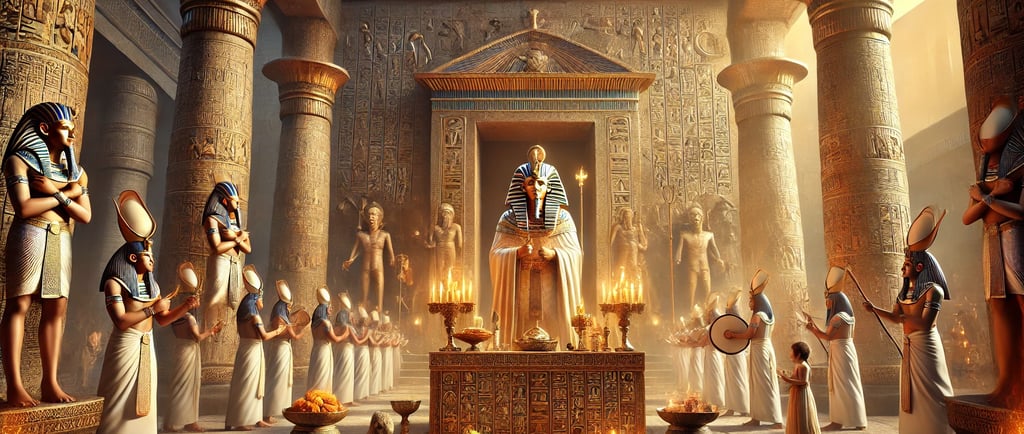13 Ways Our Ancestors Sought Instant Gratification
While humans remain humans, and so do our ways of seeking emotional rewards, what was different in the past? As there was not as many accessible options for consumption and consumerism was not yet such a big phenomenon, our ancestor focused on other ways to seek instant gratification. Lets dive into these, and you might discover a few that you did not know of.
INSTANT GRATIFICATIONHISTORYCONSUMERISM
1/21/20256 min read


Before the rise of consumerism, instant gratification existed in various forms across cultures and eras, with individuals seeking immediate satisfaction of their desires through different means. Here’s a list and description of how people throughout history obtained instant gratification:
1. Feasts and Festivals
In ancient societies, feasts and festivals were central to communal life, providing opportunities for instant gratification. These events often involved an abundance of food, drink, music, dance, and entertainment, offering immediate pleasure to participants.
Ancient Rome: Public banquets, gladiatorial games, and Saturnalia (a festival dedicated to Saturn) allowed citizens to indulge in food, entertainment, and revelry. Such events were used as tools to maintain social order and appease the populace.
Ancient Romans, particularly during festivals, indulged in large feasts and celebrations as a form of instant gratification, often pushing the boundaries of indulgence.
Saturnalia Festivities: During this festival, the Romans celebrated with lavish feasts and social inversions, where slaves and masters would temporarily switch roles. The goal was to enjoy food, drink, and revelry in a way that provided immediate joy and a temporary escape from societal norms.
Gluttony at Feasts: Some wealthy Romans would partake in extravagant feasts, eating to excess, sometimes even inducing vomiting to continue indulging in food and drink, seeking immediate pleasure through indulgence.
Medieval Europe: Kings and nobles often hosted grand feasts, where both food and entertainment were immediate sources of gratification for guests. Harvest festivals in villages also offered similar pleasures.
2. Religious Rituals and Ceremonies
Throughout history, people have often turned to religious rituals to experience a sense of immediate fulfillment or connection with higher powers.
Ancient Egypt: Rituals involving offerings, prayers, and music were believed to provide spiritual satisfaction and sometimes immediate physical rewards (such as fertility or protection).
Hinduism and Buddhism: Temples and pilgrimages have long been sites where worshippers seek instant gratification through offerings, prayers, and rituals that promise blessings, relief from suffering, or connection with the divine.
Shamanism: Indigenous peoples often sought instant gratification through shamanic ceremonies, where rituals involving drumming, chanting, and hallucinogens produced immediate spiritual or emotional experiences.
3. Performing Arts and Entertainment
Entertainment in various forms has always been a way to escape reality and experience instant joy.
Ancient Greece: Theaters and plays were major forms of entertainment that offered immediate emotional experiences, from tragedy to comedy.
Ancient Rome: Gladiatorial games, chariot races, and theatrical performances were organized to provide instant excitement and pleasure to the masses.
Medieval Europe: Jesters, minstrels, and traveling troupes provided entertainment in courts and towns, offering laughter and enjoyment in the form of songs, dances, and jokes.
4. Hunting and Gathering
In prehistoric and early human societies, hunting, fishing, and gathering were ways of obtaining immediate rewards, such as food and survival.
Paleolithic Era: The act of hunting or gathering provided immediate gratification through the procurement of food and resources necessary for survival.
Indigenous Peoples: Hunting for sport or sustenance, as well as fishing, were means of instant satisfaction, often accompanied by social rituals and community sharing.
5. Physical Achievements and Competitions
Competition and physical feats were significant sources of instant gratification in many cultures, from athletic performances to combat.
Ancient Greece: The Olympic Games provided a way for individuals to achieve glory and recognition through immediate physical prowess and competition.
Viking and Norse Cultures: Combat, feasting, and games were ways for warriors to achieve personal glory and satisfaction, often with immediate rewards such as treasure or recognition.
Medieval Tournaments: Jousting and other knightly tournaments were major forms of entertainment for nobles and allowed immediate rewards such as honor, fame, and prizes.
6.Pleasure from Alcohol and Psychoactive Substances
Humans have used intoxicants throughout history to experience altered states of consciousness, relaxation, or emotional release, providing instant gratification.
Ancient Egypt and Mesopotamia: Beer and wine were often consumed in abundance, especially during communal meals, festivals, or religious ceremonies.
Ancient Greece: Wine played a significant role in social and religious events, and the Symposium was a gathering where intellectual conversation and indulgence in wine and other pleasures were key features.
Shamanic and Traditional Cultures: Many indigenous cultures used psychoactive plants or substances like peyote, ayahuasca, and tobacco to induce altered states of consciousness, often leading to immediate emotional or spiritual release.
Amazonian Tribes (Ayahuasca Rituals): Indigenous peoples in the Amazon have long used ayahuasca, a powerful plant brew, in ceremonies to achieve immediate spiritual clarity or insights, often involving deep introspection or visions.
Mesoamerican Practices (Psychedelic Plants): Cultures like the Aztecs used hallucinogenic mushrooms in ceremonies, believing that ingesting them allowed them to communicate with gods and gain immediate spiritual guidance.
7. Physical Comfort and Bodily Pleasure
The search for immediate physical comfort was another form of gratification, especially in more physically demanding environments or during times of hardship.
Ancient Rome: Bathhouses provided immediate physical relief and relaxation through hot and cold baths, massages, and social interaction.
Ancient China: Practices such as acupuncture, herbal medicine, and massage therapies were used to obtain relief from physical discomfort almost immediately.
Medieval Europe: Bathing, although rare, was often seen as a way to rejuvenate and refresh the body, while herbal concoctions offered temporary relief from ailments.
8. Sexual Pleasure and Desire Fulfillment
Humans have always sought to satisfy sexual desires and other personal pleasures, often in ways that provided immediate gratification.
Ancient Greece and Rome: Sexuality was more openly acknowledged, and many people indulged in short-term pleasures in brothels, with sacred prostitution being practiced in some temples as a way to achieve both pleasure and religious or spiritual satisfaction.
Rituals and Celebrations: In some societies, festivals like those in ancient Babylon involved fertility rituals, orgies, or practices intended to satisfy sexual desires immediately.
9. Ritualistic Self-Discipline (Medieval Christianity and Other Traditions)
In some religious traditions, people engaged in intense physical acts to experience immediate spiritual or emotional release, believing it brought them closer to the divine.
Medieval Christian Penances: Some religious devotees practiced self-discipline through acts like self-whipping or fasting, believing such actions would cleanse them of sin and offer immediate spiritual peace.
Sufi Mysticism: In Sufi traditions, certain practices like physical exertion or ritualistic movements were believed to provide immediate spiritual satisfaction and a deep connection with the divine.
10. Sacred Ceremonies Involving Physical Acts (Various Ancient Cultures)
Certain cultures incorporated physical rituals and acts into religious or social ceremonies, where people sought immediate spiritual or emotional fulfillment.
Sacred Prostitution (Ancient Mesopotamia): In ancient Mesopotamian temples, women sometimes performed sexual rituals as offerings to the gods, with the belief that these acts would bring immediate prosperity and blessings.
Rituals of Fertility: Many ancient cultures, including those in Greece and the Near East, included fertility rituals in which physical acts symbolizing renewal and prosperity were believed to bring instant spiritual and physical gratification.
11. Extreme Physical Acts for Power (Various Cultures)
In some cultures, individuals sought power or social recognition through extreme physical acts, which brought them instant social or spiritual rewards.
Body Modification (Polynesia and Africa): In various African and Polynesian societies, people engaged in practices such as scarification or tattooing, which were believed to bring immediate prestige, spiritual power, or connection to the community.
Foot Binding (China): The practice of foot binding in China was considered a symbol of beauty and status. Women who had their feet bound in painful rituals achieved an immediate sense of social acceptance and admiration, despite the long-term physical cost.
12. Exhibitions of Power and Violence (Ancient Rome and Other Societies)
Public displays of violence or power, often in the form of public spectacles, provided immediate gratification for spectators, often through a mixture of fear, fascination, and excitement.
Gladiatorial Games (Ancient Rome): The Romans enjoyed gladiatorial combat, where warriors fought for their lives in grand arenas. This violent spectacle provided instant excitement and gratification for the audience, who thrived on the adrenaline of the fight.
Public Executions (Medieval Europe): Public executions were often treated as events for entertainment, with crowds gathering to witness punishment. This form of spectacle offered immediate gratification to those who took pleasure in the display of justice or punishment.
13. Physical Pleasure Through Ritualized Pain (Various Cultures)
In some cultures, individuals sought immediate gratification through the deliberate experience of pain, which was often tied to a sense of emotional release or catharsis.
Pain as Ritual (Various Sufi and Indigenous Practices): Some Sufi traditions and indigenous practices used physical exertion or pain in rituals to achieve a sense of spiritual clarity or immediate emotional release, where the suffering was thought to bring enlightenment or connection to higher states of consciousness.
Fasting and Purification (Ancient Egypt and India): Certain religious traditions encouraged fasting or other forms of physical self-restraint as a way to cleanse the body, which was believed to provide immediate spiritual rewards or insights.
Conclusion
Throughout history, individuals sought instant gratification in ways that varied by culture, geography, and time period. While modern consumerism emphasizes the acquisition of material goods, early forms of instant gratification were centered on food, pleasure, entertainment, social status, and religious or spiritual fulfillment. In many cases, these forms of satisfaction were more communal and ritualistic, providing immediate rewards through social and cultural engagement.
